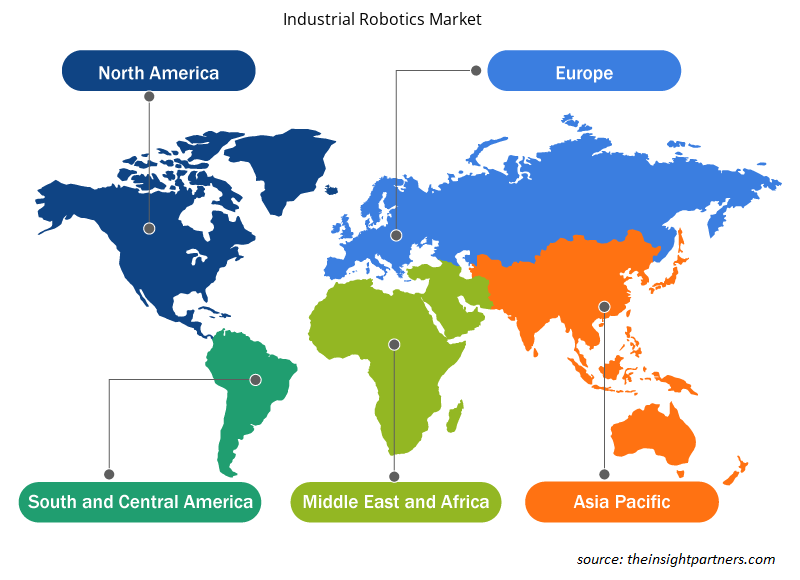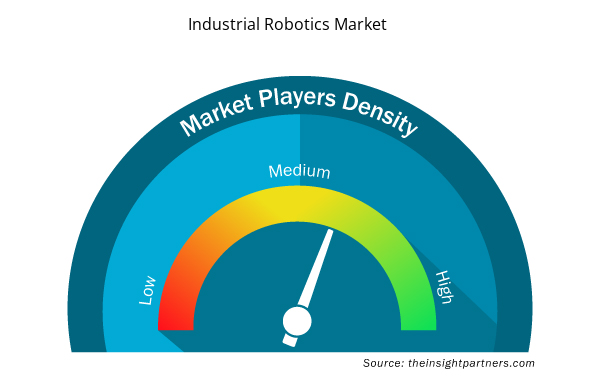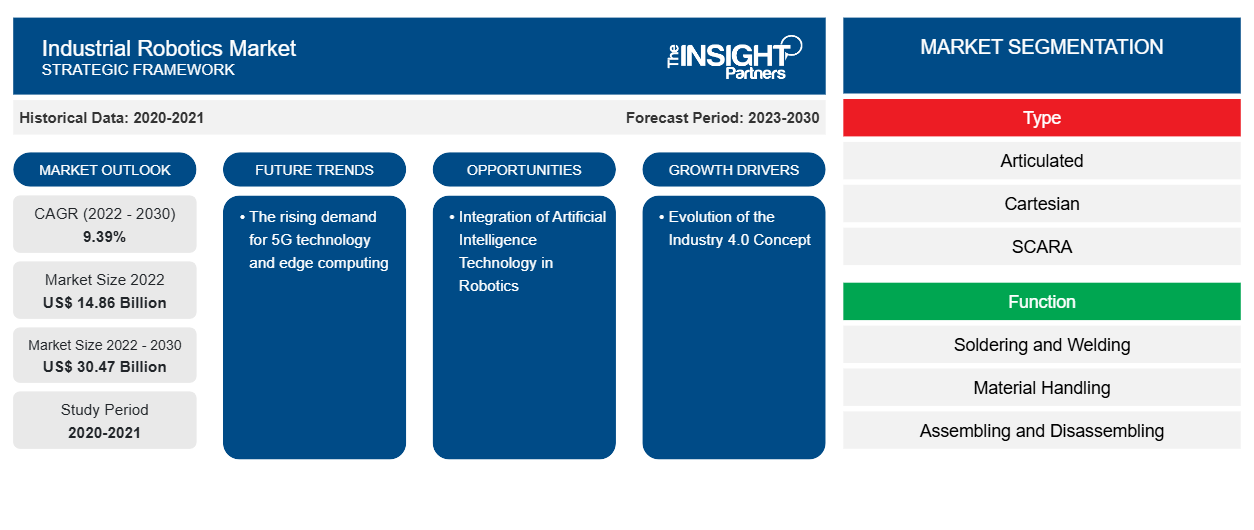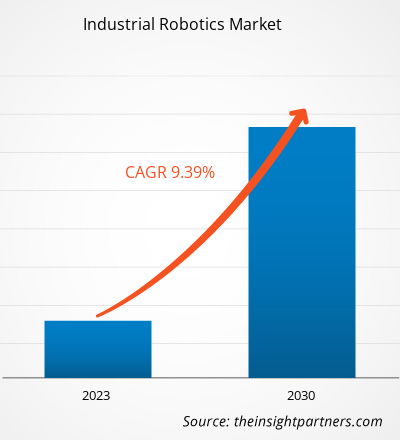من المتوقع أن يصل حجم سوق الروبوتات الصناعية إلى 30.47 مليار دولار أمريكي بحلول عام 2030 من 14.86 مليار دولار أمريكي في عام 2022. ومن المتوقع أن يسجل السوق معدل نمو سنوي مركب بنسبة 9.39٪ خلال الفترة 2022-2030. ومن المرجح أن يظل الطلب المتزايد على تقنية الجيل الخامس والحوسبة الحافة من الاتجاهات الرئيسية في السوق.CAGR of 9.39% during 2022–2030. The rising demand for 5G technology and edge computing is likely to remain a key trends in the market.
تحليل سوق الروبوتات الصناعية
إن تطور مفهوم الصناعة 4.0 والطلب المتزايد على الروبوتات التعاونية لتعزيز الكفاءة التشغيلية هي العوامل التي تدفع السوق. ومن المتوقع أن ينمو السوق خلال فترة التوقعات بسبب الطلب المتزايد على الأتمتة في صناعات التصنيع والمستودعات والخدمات اللوجستية. علاوة على ذلك، فإن دمج تكنولوجيا الذكاء الاصطناعي في الروبوتات يخلق فرصًا مربحة للسوق.
نظرة عامة على سوق الروبوتات الصناعية
يمكن تعريف الروبوتات الصناعية بأنها أذرع آلية مزودة بأجهزة استشعار وضوابط يمكنها تنفيذ مجموعة متنوعة من الوظائف والعمليات في إنشاء المنتجات الصناعية. يتم برمجتها لأداء مهام متكررة في دورات. تقلل هذه الروبوتات بشكل كبير من العناصر البشرية المشاركة في الإنتاج مع زيادة سرعة المعالجة والجودة والقدرة الإنتاجية. لا شك أن أهم مكون في الروبوت هو الذراع، والذي يتكون من مفاصل واتصالات. أداة نهاية الذراع (EOAT) هي المكون الأكثر أهمية في الذراع الآلية. إنها تتولى مجموعة متنوعة من المهام، بما في ذلك الوسم والقطع واللحام والحفر والطلاء والتنظيف.EOAT) is the most critical component of the robotic arm. They undertake a variety of tasks, including marking, cutting, welding, drilling, painting, and cleaning.
قم بتخصيص هذا التقرير ليناسب متطلباتك
ستحصل على تخصيص لأي تقرير - مجانًا - بما في ذلك أجزاء من هذا التقرير، أو تحليل على مستوى الدولة، وحزمة بيانات Excel، بالإضافة إلى الاستفادة من العروض والخصومات الرائعة للشركات الناشئة والجامعات
- احصل على أهم اتجاهات السوق الرئيسية لهذا التقرير.ستتضمن هذه العينة المجانية تحليلاً للبيانات، بدءًا من اتجاهات السوق وحتى التقديرات والتوقعات.
محركات وفرص سوق الروبوتات الصناعية
تطور مفهوم الصناعة 4.0 لصالح السوق
يشير مصطلح الصناعة 4.0 إلى الثورة الصناعية الحالية، والتي يقودها التقدم في مجال الروبوتات والأتمتة وإنترنت الأشياء. ومن المرجح أن يكون لارتفاع عدد الآلات الصناعية والذكاء الاصطناعي تأثير عميق على الروبوتات. تمكن تقنية الصناعة 4.0 من استراتيجيات الصيانة الجديدة والروبوتات المستقلة وتقنيات الروبوتات التعاونية. ومن المتوقع أن يكون لاستراتيجيات الصيانة الجديدة والذكاء الاصطناعي تأثير كبير على الروبوتات. تتمتع الروبوتات الصناعية وتقنيات الصناعة 4.0 بالقدرة على تغيير الأعمال في السنوات القادمة من خلال تحسين إدارة الآلات وأتمتة المهام اليدوية سابقًا، وهو ما من المتوقع أن يغذي النمو في سوق الروبوتات الصناعية.IoT). The rise of industrial lot and
دمج تقنية الذكاء الاصطناعي في الروبوتات
إن الذكاء الاصطناعي يقود تقدمًا ملحوظًا في قطاع الروبوتات والأتمتة. ومع تطور الذكاء الاصطناعي في مجال الروبوتات وازدهاره، تستفيد العديد من الصناعات من هذه التقنيات المتطورة، مثل تنفيذ عمليات آلية ذكية لتغذية جمع البيانات وتحليلها المتطور، مما يسمح للشركات والخدمات والشركات المصنعة باتخاذ قرارات تعتمد على البيانات، أو تنفيذ روبوتات التعلم الذاتي لتسهيل عمليات العمل والمهام. ومن المتوقع أن يؤدي تبني روبوتات التعلم الذاتي القائمة على الذكاء الاصطناعي إلى خلق فرص في السوق خلال فترة التنبؤ.
تقرير تحليل تجزئة سوق الروبوتات الصناعية
إن القطاعات الرئيسية التي ساهمت في اشتقاق تحليل سوق الروبوتات الصناعية هي النوع والوظيفة والصناعة.
- بناءً على النوع، ينقسم سوق الروبوتات الصناعية إلى مفصلية، وديكارتية، وSCARA، وتعاونية، ومتوازية، وغيرها. احتلت شريحة المفصلات حصة سوقية أكبر في عام 2022.cartesian, SCARA, collaborative, parallel, and others. The articulated segment held a larger market share in 2022.
- من حيث الوظيفة، يتم تقسيم السوق إلى اللحام واللحام، ومناولة المواد، والتجميع والتفكيك، والطلاء والتوزيع، والطحن، والقطع والمعالجة. احتل قطاع مناولة المواد حصة سوقية أكبر في عام 2022.
- على أساس الصناعة، ينقسم السوق إلى السيارات، والأدوية والمستلزمات الطبية، والكهرباء والإلكترونيات، والمطاط والبلاستيك، والمعادن والآلات ، والأغذية والزراعة. احتل قطاع الأغذية والزراعة حصة سوقية أكبر في عام 2022.
تحليل حصة سوق الروبوتات الصناعية حسب المنطقة الجغرافية
ينقسم النطاق الجغرافي لتقرير سوق الروبوتات الصناعية بشكل أساسي إلى خمس مناطق: أمريكا الشمالية، ومنطقة آسيا والمحيط الهادئ، وأوروبا، والشرق الأوسط وأفريقيا، وأمريكا الجنوبية والوسطى.
من المتوقع أن يتوسع السوق في أوروبا خلال الفترة المتوقعة بسبب الطلب المتزايد على الروبوتات الصناعية. ارتفعت تركيبات الروبوتات الصناعية بنسبة 33٪ في عام 2021 مقارنة بعام 2020. في عام 2021، زاد استخدام الروبوتات الصناعية بنسبة 22٪ في صناعة الإلكترونيات، و57٪ في صناعة السيارات، و29٪ في قطاع المعادن والآلات، مقارنة بعام 2020. وفقًا لـ IFR، في يناير 2023، كانت الصين واليابان وكوريا الجنوبية من بين الدول الخمس الأكثر تقدمًا من حيث تركيبات الروبوتات الصناعية السنوية، حيث شهدت سوق الروبوتات الصناعية في الصين أعلى مستوى من التطور.
رؤى إقليمية حول سوق الروبوتات الصناعية
لقد قام المحللون في Insight Partners بشرح الاتجاهات والعوامل الإقليمية المؤثرة على سوق الروبوتات الصناعية طوال فترة التوقعات بشكل شامل. يناقش هذا القسم أيضًا قطاعات سوق الروبوتات الصناعية والجغرافيا في جميع أنحاء أمريكا الشمالية وأوروبا ومنطقة آسيا والمحيط الهادئ والشرق الأوسط وأفريقيا وأمريكا الجنوبية والوسطى.

- احصل على البيانات الإقليمية المحددة لسوق الروبوتات الصناعية
نطاق تقرير سوق الروبوتات الصناعية
| سمة التقرير | تفاصيل |
|---|---|
| حجم السوق في عام 2022 | 14.86 مليار دولار أمريكي |
| حجم السوق بحلول عام 2030 | 30.47 مليار دولار أمريكي |
| معدل النمو السنوي المركب العالمي (2022 - 2030) | 9.39% |
| البيانات التاريخية | 2020-2021 |
| فترة التنبؤ | 2023-2030 |
| القطاعات المغطاة | حسب النوع
|
| المناطق والدول المغطاة | أمريكا الشمالية
|
| قادة السوق وملفات تعريف الشركات الرئيسية |
|
كثافة اللاعبين في السوق: فهم تأثيرها على ديناميكيات الأعمال
يشهد سوق الروبوتات الصناعية نموًا سريعًا، مدفوعًا بالطلب المتزايد من المستخدم النهائي بسبب عوامل مثل تفضيلات المستهلكين المتطورة والتقدم التكنولوجي والوعي المتزايد بفوائد المنتج. ومع ارتفاع الطلب، تعمل الشركات على توسيع عروضها والابتكار لتلبية احتياجات المستهلكين والاستفادة من الاتجاهات الناشئة، مما يؤدي إلى زيادة نمو السوق.
تشير كثافة اللاعبين في السوق إلى توزيع الشركات أو المؤسسات العاملة في سوق أو صناعة معينة. وهي تشير إلى عدد المنافسين (اللاعبين في السوق) الموجودين في مساحة سوق معينة نسبة إلى حجمها أو قيمتها السوقية الإجمالية.
الشركات الرئيسية العاملة في سوق الروبوتات الصناعية هي:
- شركة أيه بي بي المحدودة
- شركة ياسكاوا للكهرباء
- شركة ناتشي-فوجيكوشي
- فوجي روبوتيكس
- شركة كوكا ايه جي
- الروبوتات العالمية AS
إخلاء المسؤولية : الشركات المذكورة أعلاه ليست مرتبة بأي ترتيب معين.

- احصل على نظرة عامة على أهم اللاعبين الرئيسيين في سوق الروبوتات الصناعية
أخبار سوق الروبوتات الصناعية والتطورات الأخيرة
يتم تقييم سوق الروبوتات الصناعية من خلال جمع البيانات النوعية والكمية بعد البحث الأولي والثانوي، والتي تتضمن منشورات الشركات المهمة وبيانات الجمعيات وقواعد البيانات. فيما يلي بعض التطورات في سوق الروبوتات الصناعية:
- أعادت شركة ABB Ltd التأكيد على التزامها بأحد أهم أسواق عملائها، الولايات المتحدة، من خلال البدء في تشييد مقرها الرئيسي الحالي للروبوتات ومصنع الإنتاج في أوبورن هيلز بولاية ميشيغان. ومن المقرر أن يكتمل المشروع بحلول نوفمبر 2023 ومن المتوقع أن يكلف 20 مليون دولار أمريكي. ومن المتوقع أن يخلق التوسع 72 وظيفة جديدة عالية المهارة في المنطقة، بدعم من منحة قدرها 450 ألف دولار أمريكي تعتمد على الأداء من برنامج تطوير الأعمال في ميشيغان. (المصدر: ABB Ltd، موقع الشركة على الإنترنت، مارس 2023)
تغطية تقرير سوق الروبوتات الصناعية والمنتجات النهائية
يوفر تقرير "حجم سوق الروبوتات الصناعية والتوقعات (2020-2030)" تحليلاً مفصلاً للسوق يغطي المجالات التالية:
- حجم سوق الروبوتات الصناعية وتوقعاتها على المستويات العالمية والإقليمية والوطنية لجميع قطاعات السوق الرئيسية التي يغطيها النطاق
- اتجاهات سوق الروبوتات الصناعية بالإضافة إلى ديناميكيات السوق مثل المحركات والقيود والفرص الرئيسية
- تحليل مفصل لقوى PEST/Porter الخمس وSWOT
- تحليل سوق الروبوتات الصناعية الذي يغطي اتجاهات السوق الرئيسية والإطار العالمي والإقليمي واللاعبين الرئيسيين واللوائح والتطورات الأخيرة في السوق
- تحليل المشهد الصناعي والمنافسة الذي يغطي تركيز السوق، وتحليل خريطة الحرارة، واللاعبين البارزين، والتطورات الأخيرة لسوق الروبوتات الصناعية
- ملفات تعريف الشركة التفصيلية
- التحليل التاريخي (سنتان)، السنة الأساسية، التوقعات (7 سنوات) مع معدل النمو السنوي المركب
- تحليل PEST و SWOT
- حجم السوق والقيمة / الحجم - عالميًا وإقليميًا وقطريًا
- الصناعة والمنافسة
- مجموعة بيانات Excel


- Diaper Packaging Machine Market
- Railway Braking System Market
- Sports Technology Market
- Sleep Apnea Diagnostics Market
- Emergency Department Information System (EDIS) Market
- Antibiotics Market
- Equipment Rental Software Market
- Fixed-Base Operator Market
- Helicopters Market
- Pharmacovigilance and Drug Safety Software Market

Report Coverage
Revenue forecast, Company Analysis, Industry landscape, Growth factors, and Trends

Segment Covered
This text is related
to segments covered.

Regional Scope
North America, Europe, Asia Pacific, Middle East & Africa, South & Central America

Country Scope
This text is related
to country scope.
الأسئلة الشائعة
The global industrial robotics market is expected to reach US$ 30.47 billion by 2030.
The key players holding majority shares in the global industrial robotics market are Fanuc Corp, ABB Ltd, Yaskawa Electric, KUKA AG, Universal Robotics AS, Comau SpA, Mitsubishi Electric Corp, Seiko Epson Corp, Staubli International AG, Kawasaki Heavy Industries Ltd
The rising demand for 5G technology and edge computing to play a significant role in the global industrial robotics market in the coming years.
Asia Pacific dominated the industrial robotics market in 2022.
The evolution of the Industry 4.0 Concept and the growing demand for collaborative robots for enhancing operational efficiency are the major factors that propel the global industrial robotics market.
The global industrial robotics market is estimated to register a CAGR of 9.39% during the forecast period 2022–2030.
The List of Companies - Industrial Robotics Market
- Fanuc Corp
- ABB Ltd
- Yaskawa Electric
- KUKA AG
- Universal Robotics AS
- Comau SpA
- Mitsubishi Electric Corp
- Seiko Epson Corp
- Staubli International AG
- Kawasaki Heavy Industries Ltd
The Insight Partners performs research in 4 major stages: Data Collection & Secondary Research, Primary Research, Data Analysis and Data Triangulation & Final Review.
- Data Collection and Secondary Research:
As a market research and consulting firm operating from a decade, we have published and advised several client across the globe. First step for any study will start with an assessment of currently available data and insights from existing reports. Further, historical and current market information is collected from Investor Presentations, Annual Reports, SEC Filings, etc., and other information related to company’s performance and market positioning are gathered from Paid Databases (Factiva, Hoovers, and Reuters) and various other publications available in public domain.
Several associations trade associates, technical forums, institutes, societies and organization are accessed to gain technical as well as market related insights through their publications such as research papers, blogs and press releases related to the studies are referred to get cues about the market. Further, white papers, journals, magazines, and other news articles published in last 3 years are scrutinized and analyzed to understand the current market trends.
- Primary Research:
The primarily interview analysis comprise of data obtained from industry participants interview and answers to survey questions gathered by in-house primary team.
For primary research, interviews are conducted with industry experts/CEOs/Marketing Managers/VPs/Subject Matter Experts from both demand and supply side to get a 360-degree view of the market. The primary team conducts several interviews based on the complexity of the markets to understand the various market trends and dynamics which makes research more credible and precise.
A typical research interview fulfils the following functions:
- Provides first-hand information on the market size, market trends, growth trends, competitive landscape, and outlook
- Validates and strengthens in-house secondary research findings
- Develops the analysis team’s expertise and market understanding
Primary research involves email interactions and telephone interviews for each market, category, segment, and sub-segment across geographies. The participants who typically take part in such a process include, but are not limited to:
- Industry participants: VPs, business development managers, market intelligence managers and national sales managers
- Outside experts: Valuation experts, research analysts and key opinion leaders specializing in the electronics and semiconductor industry.
Below is the breakup of our primary respondents by company, designation, and region:

Once we receive the confirmation from primary research sources or primary respondents, we finalize the base year market estimation and forecast the data as per the macroeconomic and microeconomic factors assessed during data collection.
- Data Analysis:
Once data is validated through both secondary as well as primary respondents, we finalize the market estimations by hypothesis formulation and factor analysis at regional and country level.
- Macro-Economic Factor Analysis:
We analyse macroeconomic indicators such the gross domestic product (GDP), increase in the demand for goods and services across industries, technological advancement, regional economic growth, governmental policies, the influence of COVID-19, PEST analysis, and other aspects. This analysis aids in setting benchmarks for various nations/regions and approximating market splits. Additionally, the general trend of the aforementioned components aid in determining the market's development possibilities.
- Country Level Data:
Various factors that are especially aligned to the country are taken into account to determine the market size for a certain area and country, including the presence of vendors, such as headquarters and offices, the country's GDP, demand patterns, and industry growth. To comprehend the market dynamics for the nation, a number of growth variables, inhibitors, application areas, and current market trends are researched. The aforementioned elements aid in determining the country's overall market's growth potential.
- Company Profile:
The “Table of Contents” is formulated by listing and analyzing more than 25 - 30 companies operating in the market ecosystem across geographies. However, we profile only 10 companies as a standard practice in our syndicate reports. These 10 companies comprise leading, emerging, and regional players. Nonetheless, our analysis is not restricted to the 10 listed companies, we also analyze other companies present in the market to develop a holistic view and understand the prevailing trends. The “Company Profiles” section in the report covers key facts, business description, products & services, financial information, SWOT analysis, and key developments. The financial information presented is extracted from the annual reports and official documents of the publicly listed companies. Upon collecting the information for the sections of respective companies, we verify them via various primary sources and then compile the data in respective company profiles. The company level information helps us in deriving the base number as well as in forecasting the market size.
- Developing Base Number:
Aggregation of sales statistics (2020-2022) and macro-economic factor, and other secondary and primary research insights are utilized to arrive at base number and related market shares for 2022. The data gaps are identified in this step and relevant market data is analyzed, collected from paid primary interviews or databases. On finalizing the base year market size, forecasts are developed on the basis of macro-economic, industry and market growth factors and company level analysis.
- Data Triangulation and Final Review:
The market findings and base year market size calculations are validated from supply as well as demand side. Demand side validations are based on macro-economic factor analysis and benchmarks for respective regions and countries. In case of supply side validations, revenues of major companies are estimated (in case not available) based on industry benchmark, approximate number of employees, product portfolio, and primary interviews revenues are gathered. Further revenue from target product/service segment is assessed to avoid overshooting of market statistics. In case of heavy deviations between supply and demand side values, all thes steps are repeated to achieve synchronization.
We follow an iterative model, wherein we share our research findings with Subject Matter Experts (SME’s) and Key Opinion Leaders (KOLs) until consensus view of the market is not formulated – this model negates any drastic deviation in the opinions of experts. Only validated and universally acceptable research findings are quoted in our reports.
We have important check points that we use to validate our research findings – which we call – data triangulation, where we validate the information, we generate from secondary sources with primary interviews and then we re-validate with our internal data bases and Subject matter experts. This comprehensive model enables us to deliver high quality, reliable data in shortest possible time.


 احصل على عينة مجانية لهذا التقرير
احصل على عينة مجانية لهذا التقرير